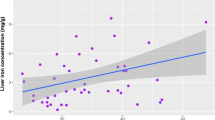Abstract
Neonatal hemochromatosis is a rare condition that causes neonatal liver failure, frequently resulting in fetal loss or neonatal death. It is thought that most cases of neonatal hemochromatosis are caused by gestational alloimmune liver disease (GALD), with neonatal hemochromatosis being a phenotype of GALD rather than a disease process. Extrahepatic siderosis in the pancreas, myocardium, thyroid and minor salivary gland is a characteristic feature of neonatal hemochromatosis. There is also sparing of the reticuloendothelial system with no iron deposition in the spleen. Hepatic and extrahepatic siderosis seen in neonatal hemochromatosis is from iron dysregulation secondary to liver damage rather than iron deposition causing the liver damage. The presence of extrahepatic siderosis in the pancreas and thyroid is diagnostic of neonatal hemochromatosis and can be detected noninvasively by multi-echo gradient recalled echo (GRE) T2*-weighted sequence of MRI within hours of birth. This helps to expedite the treatment in the form of intravenous immunoglobulin and exchange transfusion, which improves the survival in these babies. The finding of hepatic siderosis is nonspecific and does not help in the diagnosis of neonatal hemochromatosis because it is seen with other causes of advanced liver disease.


Similar content being viewed by others
References
Feldman AG, Whitington PF (2013) Neonatal hemochromatosis. J Clin Exp Hepatol 3:313–320
Zozaya Nieto C, Fernández Caamaño B, Muñoz Bartolo G et al (2017) Presenting features and prognosis of ischemic and nonischemic neonatal liver failure. J Pediatr Gastroenterol Nutr 64:754–759
Bitar R, Thwaites R, Davison S et al (2017) Liver failure in early infancy: aetiology, presentation, and outcome. J Pediatr Gastroenterol Nutr 64:70–75
Lone KS, AlSaleem B, Asery A et al (2020) Liver failure among young Saudi infants: etiology, clinical presentation, and outcome. J Pediatr Gastroenterol Nutr 70:e26–e32
Heissat S, Collardeau-Frachon S, Baruteau J et al (2015) Neonatal hemochromatosis: diagnostic work-up based on a series of 56 cases of fetal death and neonatal liver failure. J Pediatr 166:66–73
Rand EB, Karpen SJ, Kelly S et al (2009) Treatment of neonatal hemochromatosis with exchange transfusion and intravenous immunoglobulin. J Pediatr 155:566–571
Alenezi K, Kamath BM, Siddiqui I et al (2018) Magnetic resonance imaging findings in neonatal hemochromatosis. J Pediatr Gastroenterol Nutr 66:581–587
Hayes AM, Jaramillo D, Levy HL, Knisely AS (1992) Neonatal hemochromatosis: diagnosis with MR imaging. AJR Am J Roentgenol 159:623–625
Silver MM, Beverley DW, Valberg LS et al (1987) Perinatal hemochromatosis. Clinical, morphologic, and quantitative iron studies. Am J Pathol 128:538–554
Moerman P, Pauwels P, Vandenberghe K et al (1990) Neonatal haemochromatosis. Histopathology 17:345–351
Collardeau-Frachon S, Heissat S, Bouvier R et al (2012) French retrospective multicentric study of neonatal hemochromatosis: importance of autopsy and autoimmune maternal manifestations. Pediatr Dev Pathol 15:450–470
Pan X, Kelly S, Melin-Aldana H et al (2010) Novel mechanism of fetal hepatocyte injury in congenital alloimmune hepatitis involves the terminal complement cascade. Hepatology 51:2061–2068
Debray FG, de Halleux V, Guidi O et al (2012) Neonatal liver cirrhosis without iron overload caused by gestational alloimmune liver disease. Pediatrics 129:e1076–e1079
Tsunoda T, Inui A, Kawamoto M et al (2015) Neonatal liver failure owing to gestational alloimmune liver disease without iron overload. Hepatol Res 45:601–605
Sciard C, Collardeau-Frachon S, Atallah A et al (2019) Prenatal imaging features suggestive of liver gestational allo immune disease. J Gynecol Obstet Hum Reprod 48:61–64
Whitington PF, Pan X, Kelly S et al (2011) Gestational alloimmune liver disease in cases of fetal death. J Pediatr 159:612–616
Dubruc E, Nadaud B, Ruchelli E et al (2017) Relevance of C5b9 immunostaining in the diagnosis of neonatal hemochromatosis. Pediatr Res 81:712–721
Whitington PF, Kelly S (2008) Outcome of pregnancies at risk for neonatal hemochromatosis is improved by treatment with high-dose intravenous immunoglobulin. Pediatrics 121:e1615–e1621
Lopriore E, Mearin ML, Oepkes D et al (2013) Neonatal hemochromatosis: management, outcome, and prevention. Prenat Diagn 33:1221–1225
Whitington PF, Kelly S, Taylor SA et al (2018) Antenatal treatment with intravenous immunoglobulin to prevent gestational alloimmune liver disease: comparative effectiveness of 14-week versus 18-week initiation. Fetal Diagn Ther 43:218–225
Knisely AS (2014) Patent ductus venosus and acute liver failure in the neonate: consider neonatal hemochromatosis with liver scarring. Liver Transpl 20:124
Schoennagel BP, Remus CC, Wedegaertner U et al (2014) Quantification of prenatal liver and spleen iron in a sheep model and assessment of iron stores in a human neonate with neonatal hemochromatosis using R2* mapping. Magn Reson Med Sci 13:167–173
Author information
Authors and Affiliations
Corresponding author
Ethics declarations
Conflicts of interest
None
Additional information
Publisher’s note
Springer Nature remains neutral with regard to jurisdictional claims in published maps and institutional affiliations.
Rights and permissions
About this article
Cite this article
Chavhan, G.B., Kamath, B.M., Siddiqui, I. et al. Magnetic resonance imaging of neonatal hemochromatosis. Pediatr Radiol 52, 334–339 (2022). https://doi.org/10.1007/s00247-021-05008-9
Received:
Revised:
Accepted:
Published:
Issue Date:
DOI: https://doi.org/10.1007/s00247-021-05008-9




